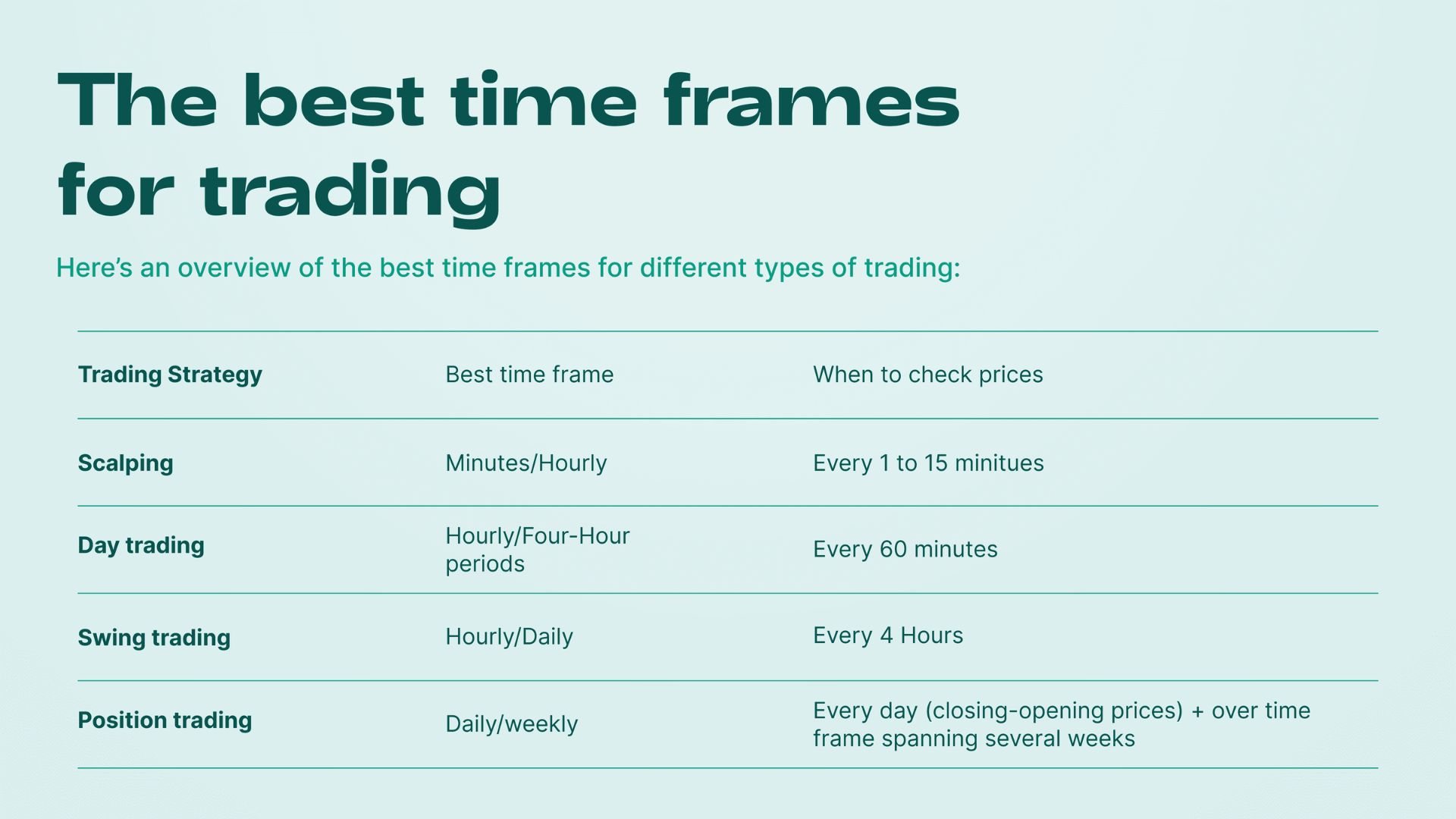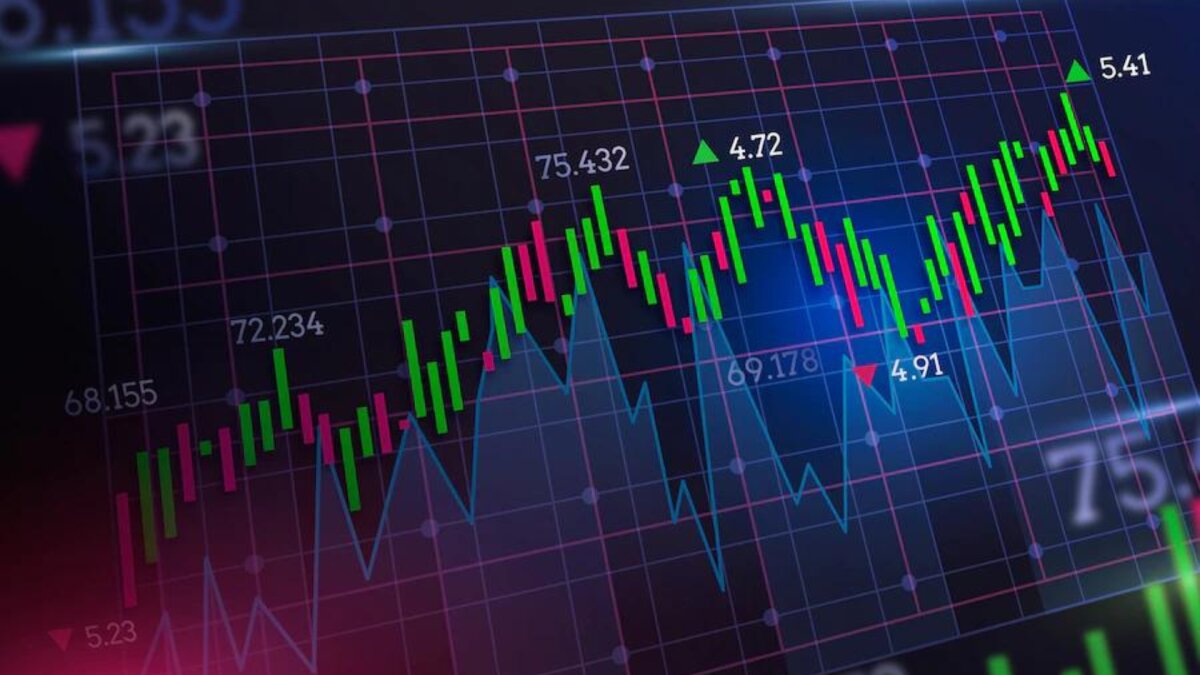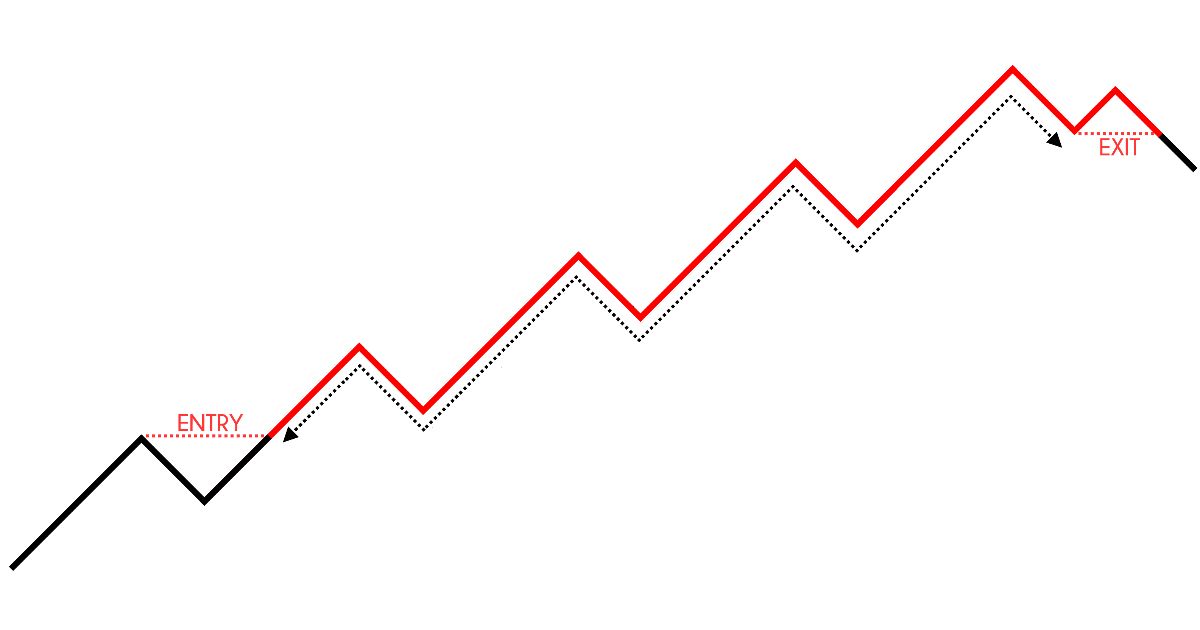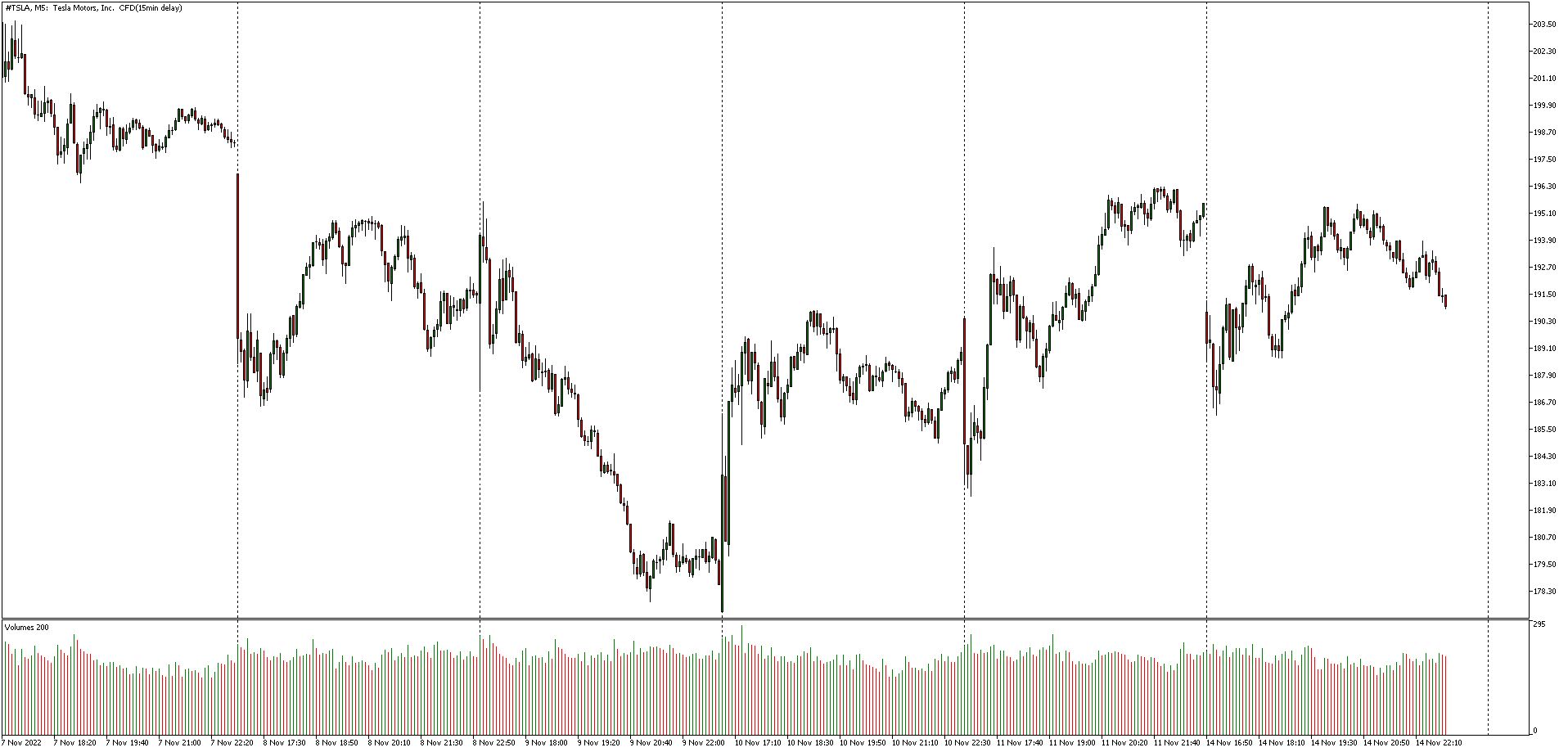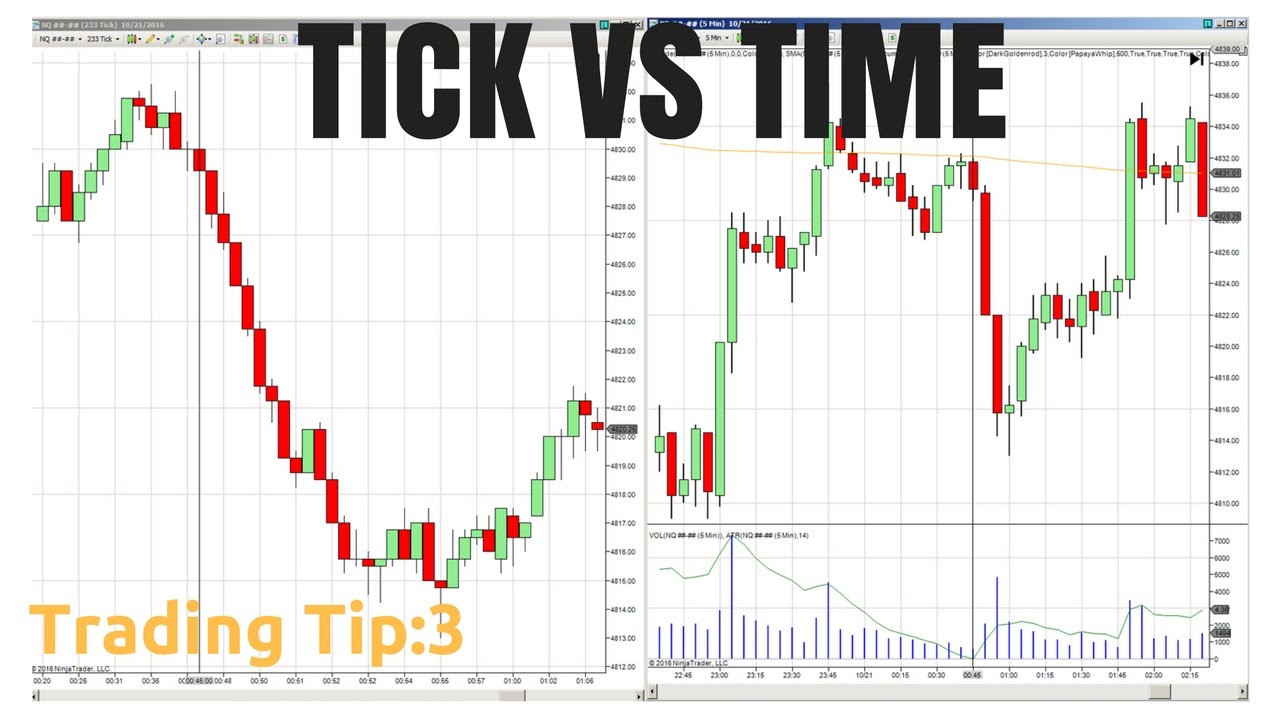Introduction
Day trading is a popular strategy in the financial market that involves buying and selling financial instruments within the same trading day. It is a fast-paced and dynamic form of trading that requires traders to make quick decisions and execute trades based on short-term price movements.
When it comes to day trading, the time frame plays a crucial role in determining the success or failure of a trade. The time frame refers to the duration for which a trader holds a position in a particular trade. Choosing the right time frame is essential as it allows traders to align their strategies with the market conditions and maximize their profit potential.
There are various time frames available for day traders, each catering to different trading styles and objectives. Scalping, intraday trading, swing trading, and position trading are some of the commonly used time frames in day trading.
Understanding the characteristics and advantages of each time frame is vital for day traders to make informed decisions. In this article, we will explore the different time frames used in day trading and discuss the factors that traders should consider when choosing the most suitable time frame for their trading style and goals.
Understanding Day Trading
Before delving into the importance of time frames in day trading, let’s first understand the concept of day trading itself. Day trading involves the buying and selling of financial assets, such as stocks, currencies, or commodities, within the same trading day. Unlike long-term investing, where positions are held for extended periods, day traders aim to profit from short-term price fluctuations.
Day trading requires a high level of skill, discipline, and knowledge about the financial markets. Traders rely on technical analysis, market trends, and other indicators to identify potential trading opportunities. They execute trades quickly and aim to capitalize on small price movements. The goal is to generate consistent profits by taking advantage of volatility and market fluctuations.
One of the key advantages of day trading is the ability to take advantage of leverage. Many day traders use margin accounts, which allow them to trade with borrowed money. This amplifies both potential gains and losses, making risk management a critical aspect of day trading.
Due to the fast-paced nature of day trading, traders need to stay updated on market news, economic indicators, and other factors that may impact the price movements of their chosen assets. This requires constant monitoring and analysis of the market, which can be time-consuming and demanding.
Day traders employ various trading strategies, such as scalping, momentum trading, and range trading, to exploit short-term price fluctuations. They may also use technical tools, such as moving averages, volume indicators, and chart patterns, to identify entry and exit points.
It is important to note that day trading is not without risks. The volatile nature of the financial markets means that prices can change rapidly, potentially leading to substantial losses. Successful day traders employ effective risk management techniques, such as setting stop-loss orders and using proper position sizing, to protect their capital.
Overall, day trading offers the potential for significant profits, but it requires a combination of knowledge, skill, and discipline. Traders must understand the intricacies of the market, develop a sound trading plan, and continuously adapt their strategies to changing market conditions.
Importance of Time Frame in Day Trading
The time frame is a critical aspect of day trading as it determines the duration for which a trader holds a position. It plays a significant role in shaping the trading strategy, risk management approach, and profit potential. Understanding the importance of time frames is essential for day traders in making informed decisions.
The time frame impacts the level of risk and potential return in a trade. Shorter time frames, such as scalping or intraday trading, involve quick trades that last from a few seconds to a few hours. These trades aim to capture small price movements and generate profits based on frequent trades. On the other hand, longer time frames, like swing trading or position trading, involve holding positions for days, weeks, or even months to capitalize on larger price movements.
Moreover, the time frame influences the trading style and approach. For example, scalpers focus on quick, high-volume trades, while swing traders aim to capture larger market moves. Each time frame requires a different mindset and skillset, as well as specific technical indicators or chart patterns that are more relevant for that particular time frame. Understanding and choosing the right time frame is crucial for aligning the trading strategy with the desired outcomes.
Another critical aspect of time frames is the management of market noise and volatility. Shorter time frames may be more susceptible to frequent price fluctuations and market noise, requiring traders to react quickly and make rapid decisions. Conversely, longer time frames smooth out the noise, allowing traders to take a more macroscopic view of the market. The choice of time frame depends on a trader’s risk tolerance, time commitment, and ability to handle market volatility.
Additionally, the time frame affects the time commitment required for day trading. Scalping and intraday trading demand constant monitoring of the market to execute quick trades. Traders need to dedicate several hours a day to analyze and trade. On the other hand, swing trading or position trading offer more flexibility as traders can analyze the market and make trading decisions at their convenience. This makes the choice of time frame crucial, based on a trader’s availability and lifestyle.
Ultimately, the importance of time frame in day trading lies in optimizing trading strategies, managing risk, and aligning trading goals with market opportunities. Each time frame presents unique advantages and challenges, and traders must carefully consider their personal preferences, trading style, market conditions, and time commitment when choosing the most suitable time frame for their day trading activities.
Different Time Frames for Day Trading
Day traders have various time frames at their disposal, each offering a different approach and trading style. It is important for traders to understand the characteristics of each time frame to make informed decisions and maximize their trading potential. Let’s explore some of the commonly used time frames in day trading:
1. Scalping
Scalping is a short-term trading strategy that focuses on profiting from small price movements. Traders who employ this time frame aim to enter and exit trades within seconds to minutes. Scalpers often rely on technical indicators, such as moving averages or Fibonacci retracements, to identify quick trading opportunities. This strategy requires intense focus and quick execution to capitalize on small price differentials.
2. Intraday Trading
Intraday trading involves holding positions for a single trading day. Traders who follow this time frame typically close out all positions before the market closes. Intraday traders analyze price patterns, volume, and other technical indicators to identify trends and potential trading opportunities. This time frame offers the flexibility to capture larger price movements compared to scalping but still requires active monitoring throughout the trading day.
3. Swing Trading
Swing trading is a medium-term trading style that aims to capture price swings over several days to weeks. Traders who adopt this time frame look for trends or patterns that suggest a potential price reversal or continuation. Swing traders may use technical analysis tools, such as chart patterns or moving averages, to identify entry and exit points. This time frame allows traders to take advantage of larger market moves while also providing some flexibility in terms of time commitment.
4. Position Trading
Position trading is a long-term trading strategy that involves holding positions for weeks, months, or even years. Traders who use this time frame focus on macroeconomic factors, fundamental analysis, and long-term trends to make trading decisions. Position traders are less concerned with short-term price fluctuations and aim to capture more significant market movements. This trading style requires patience, as trades may take a significant amount of time to fully develop and generate profits.
Choosing the right time frame depends on a trader’s preferences, trading style, and market conditions. Scalping and intraday trading are suited for traders who can handle the fast-paced nature of the market and are comfortable with frequent trades. Swing trading appeals to those who want to capture medium-term trends and have a moderate level of time commitment. Position trading is for traders who have a long-term perspective and can patiently wait for significant market moves to unfold.
It is essential for day traders to understand their strengths, limitations, and trading goals when selecting a time frame. By choosing the most suitable time frame, traders can align their strategy with their trading objectives and increase their chances of success.
Scalping
Scalping is a popular time frame for day traders who aim to capitalize on small price movements within the market. This trading strategy involves entering and exiting trades within a matter of seconds to minutes, often relying on technical indicators and quick execution.
Scalpers focus on capturing small price differentials, known as “ticks” or “pips,” which can quickly add up to profits due to the high volume of trades they execute. This time frame requires precision and discipline, as scalpers need to make split-second decisions based on their analysis of price charts, volume, and other technical indicators.
Traders who use the scalp trading strategy employ various techniques to identify potential trading opportunities. They may look for short-term price patterns, such as support and resistance levels or breakouts, to determine entry and exit points. Some scalpers also use momentum indicators, such as the Relative Strength Index (RSI) or stochastic oscillator, to gauge the strength of price movements.
Risk management is crucial in scalping due to the high frequency of trades. Scalpers often set tight stop-loss orders to limit potential losses and have strict profit targets to secure profits quickly. With this approach, the goal is to generate small profits consistently while minimizing the impact of any losing trades.
Scalping requires traders to have a deep understanding of the market they are trading in. They need to be highly observant and able to interpret price action quickly. Scalpers often use Level II quotes, which show real-time bid and ask prices, to assess market depth and liquidity. This information helps them determine the best entry and exit points for their trades.
It’s important to note that scalping requires an advanced level of skill and experience. Traders need to be able to handle the stress and pressure that comes with making rapid trading decisions. Scalping may also require trading platforms with fast order execution and low transaction costs to ensure optimal results.
While scalping can be a profitable trading strategy, it is not suitable for every trader. The fast-paced nature of scalping requires dedicated time and attention. Traders need to be able to actively monitor the market and execute trades quickly, which may not be feasible for those with limited availability or other commitments.
In summary, scalping is a time frame in day trading that involves quick trades to capture small price movements. Traders who use this strategy need to have a solid understanding of the market and technical indicators. Scalping requires discipline, risk management skills, and the ability to make rapid decisions. While it can be a profitable strategy, traders need to consider their availability and ability to handle the intensity of scalping before engaging in this time frame.
Intraday Trading
Intraday trading is a popular time frame for day traders who seek to capitalize on short-term price movements within a single trading day. Unlike scalping, which aims to quickly exit trades, intraday traders hold their positions for a longer duration, typically closing them out before the market closes.
Intraday traders analyze various factors, including price patterns, indicators, and volume, to identify potential entry and exit points. They focus on the short-term momentum of the market and aim to profit from intra-day trends and market fluctuations.
Chart patterns, such as double tops or bottoms, triangles, or head and shoulders, are often used by intraday traders as signals to enter or exit trades. Technical indicators, such as moving averages, oscillators, or trend lines, can also provide valuable insights for making informed trading decisions.
With intraday trading, risk management is crucial. Traders set stop-loss orders to limit potential losses and have profit targets to secure profits. Proper position sizing is paramount to ensure that potential losses are manageable and align with the trader’s risk tolerance.
Intraday traders may use different trading styles within this time frame, such as range trading or breakout trading. Range traders seek to profit from the price moving within a defined range, buying at support levels and selling at resistance levels. Breakout traders, on the other hand, aim to profit from price breakouts above resistance or below support levels.
This time frame requires a trader to stay focused and monitor the market throughout the trading day. It demands a commitment of time and attention to analyze price movements, track relevant news and events, and adjust trading positions accordingly.
As with any trading strategy, success in intraday trading relies on a combination of skill, experience, and a solid trading plan. Traders need to have a thorough understanding of the market they are trading in and the tools they are using. It’s crucial to stay disciplined and manage emotions, especially when facing market volatility or unexpected price movements.
Intraday trading can be a suitable time frame for traders who have the time and dedication to actively engage in the market. It offers opportunities to profit from short-term trends without the intense pressure of scalping. However, it is important for traders to determine their risk tolerance and ensure they have a well-defined trading strategy to navigate the inherent risks of intraday trading.
In summary, intraday trading is a time frame in day trading that involves holding positions within a single trading day. Traders focus on short-term price movements, using technical analysis and indicators to make trading decisions. Intraday trading requires discipline, risk management skills, and the ability to monitor the market throughout the trading day. It can offer potential profits for traders who are dedicated and have a solid trading plan.
Swing Trading
Swing trading is a time frame in day trading that involves holding positions for several days to weeks, aiming to capture medium-term price movements. Unlike scalping or intraday trading, swing traders have a more relaxed approach and focus on identifying and profiting from market trends.
Swing traders analyze price patterns, technical indicators, and market trends to identify potential entry and exit points. They look for stocks, currencies, or other financial instruments that exhibit a clear upward or downward trend. The goal is to enter a trade when the price is at a swing low or high, and then exit when the price has made a significant move in the anticipated direction.
Technical tools, such as moving averages, trend lines, and Fibonacci retracements, are commonly used by swing traders to identify potential support and resistance levels and to gauge the strength of a trend. This information helps them determine favorable entry and exit points for their trades.
Due to the longer holding period, swing traders need to utilize risk management techniques to protect their capital. They set stop-loss orders to limit potential losses and trailing stop orders to secure profits as the trade moves in their favor. Position sizing is also critical to ensure that potential losses are reasonable and aligned with the trader’s risk tolerance.
Swing trading allows traders to take advantage of larger market moves compared to scalping or intraday trading. By capturing medium-term trends, swing traders have the potential to generate significant profits. However, they also need to be patient and flexible, as swing trades may take several days to weeks to fully unfold.
It’s important to note that swing trading requires a different level of time commitment compared to shorter time frames. Traders need to dedicate time for market analysis, monitoring positions, and adjusting stop-loss and take-profit levels. The frequency of trades may vary, as swing traders look for quality setups rather than trading on every potential opportunity.
Swing trading is suitable for day traders who have a moderate level of time commitment and prefer a more relaxed approach to trading. While it requires discipline and the ability to wait for trades to develop, swing trading provides the opportunity to capture larger price movements and avoid the noise and volatility associated with shorter time frames.
In summary, swing trading is a time frame in day trading that involves holding positions for several days to weeks to capture medium-term price movements. Swing traders focus on identifying and profiting from market trends by using technical analysis and indicators. This time frame requires patience, risk management skills, and a flexible approach. It can be a suitable choice for day traders who have a moderate time commitment and prefer a more relaxed trading strategy.
Position Trading
Position trading is a time frame in day trading that involves holding positions for weeks, months, or even years. Traders who engage in position trading take a long-term view of the market, aiming to capture significant market movements and profit from macroeconomic trends.
Position traders rely on fundamental analysis, macroeconomic indicators, and long-term trends to make trading decisions. They analyze factors such as economic data, geopolitical events, and industry trends to determine the direction of the market and identify potential entry and exit points. Technical analysis tools may also be used to complement their fundamental analysis.
Unlike shorter time frames, position traders are not concerned with short-term price fluctuations or intra-day volatility. They are focused on the big picture and anticipate longer-term trends. Position traders may take advantage of market cycles or major economic developments by holding positions for an extended period to fully capitalize on the expected market movement.
Risk management is crucial in position trading, as trades can be held for an extended period, exposing traders to potential market volatility. Position traders set wider stop-loss orders to allow for market fluctuations and have long-term profit targets. They also need to consider their capital allocation, as longer holding periods require a different approach to position sizing and risk management.
Position trading requires a more passive approach compared to shorter time frames. Traders need to exercise patience and discipline, avoiding unnecessary trading activity and resisting the temptation to exit positions prematurely. This time frame allows traders to take a less hands-on approach and may free up time for other endeavors or pursuits.
Position trading is suitable for traders who can take a more patient and long-term approach to the market. It requires a deep understanding of fundamental analysis, macroeconomic factors, and the ability to anticipate longer-term trends. Traders engaging in position trading often have a larger risk appetite and a long-term investment perspective.
It’s important to note that position trading may not be suitable for all traders, as it requires a substantial commitment of time and capital. The holding periods can be lengthy, and trades may require significant patience before profits materialize. Position traders must also consider the potential opportunity cost of tying up capital in long-term positions.
In summary, position trading is a time frame in day trading that involves holding positions for weeks, months, or even years. Traders take a long-term view of the market, relying on fundamental analysis and macroeconomic indicators to make trading decisions. Position trading requires patience, discipline, and the ability to anticipate longer-term trends. It is suitable for traders with a larger risk appetite and a long-term investment perspective.
Choosing the Right Time Frame for Day Trading
Choosing the right time frame is crucial in day trading, as it directly impacts the trading strategy, risk management approach, and potential profitability. Traders need to consider several factors before selecting a time frame that aligns with their trading style and goals.
Personal Preference: Personal preference plays a significant role in choosing a time frame. Traders need to assess their own comfort level with the intensity and pace of different time frames. Some traders may thrive in the fast-paced environment of scalping or intraday trading, while others may prefer the more relaxed nature of swing or position trading.
Trading Style and Strategy: Different time frames are suited to different trading styles and strategies. Scalping is ideal for traders who prefer frequent but small profits, while swing trading offers opportunities to capture larger price movements. Traders need to evaluate their strengths, weaknesses, and trading strategies to determine the time frame that best suits their approach.
Volatility and Market Conditions: The level of market volatility and the prevailing market conditions should also be considered when selecting a time frame. Highly volatile markets may be more suitable for shorter time frames, while calmer markets may be better suited for longer-term trading. Traders should also be aware of how different time frames perform during different market conditions, such as trending or range-bound markets.
Time Commitment: Traders need to evaluate their available time and commitment to day trading. Scalping and intraday trading require more active monitoring and dedication, as traders need to be constantly engaged in the market. Swing and position trading may be more suitable for those with limited time, as they offer more flexibility in terms of analysis and decision-making.
It is important for traders to experiment and evaluate different time frames using a demo account or small position sizes before committing significant capital. This allows traders to assess the suitability and profitability of a particular time frame based on their trading style and preferences.
Traders should also remember that the choice of time frame is not set in stone. As they gain experience and adapt to changing market conditions, they may find that their preferred time frame evolves. Flexibility and the ability to adjust strategies when necessary is key to successful day trading.
In summary, choosing the right time frame for day trading is vital for achieving trading goals and maximizing profitability. Traders need to consider personal preferences, trading style, market conditions, and time commitment when making this decision. It is crucial to thoroughly evaluate different time frames and adapt strategies to changing market conditions for continued success in day trading.
Factors to Consider while Choosing Time Frames
Choosing the right time frame in day trading requires careful consideration of several factors. Traders must assess these factors to ensure they align with their trading style, risk tolerance, and overall trading goals. Here are key factors to consider:
1. Personal Preference: Personal preference plays a crucial role in selecting a time frame. Traders should consider whether they thrive in the fast-paced environment of shorter time frames like scalping or intraday trading, or if they prefer the more relaxed pace of swing or position trading. Personal comfort and enjoyment of the chosen time frame can contribute to long-term trading success.
2. Trading Style and Strategy: Traders need to evaluate their trading style and strategy when choosing a time frame. Scalping may suit short-term traders looking for quick profits, while swing or position trading may appeal to those seeking to profit from larger market moves. Understanding one’s trading style and aligning it with a suitable time frame is crucial for consistent profitability.
3. Volatility and Market Conditions: Different time frames perform differently under varying market conditions. Traders must consider the level of volatility in the market and how it aligns with their chosen time frame. Shorter time frames may be more suitable for highly volatile markets, while longer time frames can be advantageous during times of low volatility or ranging markets. Understanding market conditions and how they impact different time frames is essential.
4. Time Commitment: The time commitment required for each time frame is an important consideration. Shorter time frames like scalping and intraday trading demand constant monitoring and quick decision-making. Traders must be able to commit several hours a day to actively engage in the market. Longer time frames like swing or position trading offer more flexibility, allowing traders to analyze the market and make trading decisions at their convenience. Traders must assess the time they can realistically commit to day trading and select a time frame accordingly.
By carefully considering these factors, traders can choose a time frame that aligns with their preferences, trading style, risk tolerance, and time commitment. It is important to note that the chosen time frame is not set in stone and can be adjusted as traders gain experience and adapt to changing market conditions. Continual evaluation and adjustment of the time frame ensure that it remains aligned with traders’ evolving trading goals and market dynamics.
In summary, traders must consider personal preferences, trading style, market conditions, and time commitment when selecting a time frame in day trading. Each factor contributes to the overall success and profitability in day trading. By evaluating and understanding these factors, traders can make informed decisions and choose a time frame that suits their individual trading needs and goals.
Personal Preference
Personal preference is a significant factor to consider when choosing a time frame for day trading. Each trader has their own unique trading style, personality, and comfort level, which can greatly influence their preference for a specific time frame.
Some traders thrive in the high-energy and fast-paced environment of shorter time frames like scalping or intraday trading. These traders enjoy the thrill of analyzing charts, executing trades quickly, and capturing small price movements. Scalping requires intense focus and the ability to make rapid decisions, making it suitable for traders who can handle the pressure and excitement that come with such short-term trading.
On the other hand, some traders prefer a more relaxed and patient approach to trading, which may lead them to choose longer time frames like swing or position trading. These traders are comfortable with holding positions for days, weeks, or even months, allowing them to capture larger market moves. Swing and position trading provide traders with the opportunity to take a step back, analyze the market with a broader perspective, and make more deliberate trading decisions.
Traders should consider their personality traits and trading preferences when selecting a time frame. Are they more inclined towards quick decision-making and intense focus, or do they prefer a more laid-back and patient approach? Reflecting on their natural tendencies can help traders align their trading activities with their preferences, leading to a more enjoyable and sustainable trading experience.
It is important to note that personal preference should not solely dictate the choice of a time frame. Traders need to balance their preferences with other factors, such as their trading goals, risk tolerance, and market conditions. While personal preference is an essential consideration, it should be combined with a thoughtful evaluation of other key factors to ensure a well-rounded decision.
Traders may also find that their personal preference evolves over time as they gain experience and develop their skills. They may start with a particular time frame based on their initial preferences, and as they become more knowledgeable and confident in their trading abilities, they may experiment with and transition to a different time frame that better suits their evolving trading style and preferences.
In summary, personal preference plays a significant role in selecting a time frame for day trading. Traders should consider their natural inclinations, trading style, and comfort level to align their trading activities with their preferences. However, personal preference should be balanced with other factors to ensure a holistic decision-making process that leads to a time frame that aligns with the trader’s goals, risk tolerance, and market conditions.
Trading Style and Strategy
When choosing a time frame for day trading, traders need to evaluate their trading style and strategy. Different time frames are suited to various trading styles, and aligning the time frame with the trading strategy is crucial for successful trading.
Traders who prefer quick, short-term trades may find scalping or intraday trading to be the most suitable time frame. Scalping involves making frequent trades and capturing small price movements within seconds to minutes. This style of trading requires a focus on technical indicators, rapid decision-making, and quick execution. Traders employing a scalping strategy may use tools like moving averages or volatility indicators to identify short-term trading opportunities.
In contrast, traders with a medium-term approach may opt for swing trading. Swing traders look for trends that can last for several days to weeks and aim to capture larger market moves. They employ technical analysis tools, such as trend lines or chart patterns, to identify potential entry and exit points. Swing trading allows traders to take advantage of market momentum and can be suitable for those who prefer a more relaxed trading pace.
For traders with a long-term perspective, position trading is a viable option. Position traders focus on fundamental analysis and take a broader view of the market, holding positions for weeks, months, or even years. They aim to profit from larger macroeconomic trends and market cycles. Position traders base their trading decisions on factors like economic data, geopolitical events, and long-term market forecasts.
It is important that traders choose a time frame that aligns with their trading style and strategy. Trying to force a trading style into an incompatible time frame can lead to frustration and poor trading decisions. The chosen time frame should provide enough space and opportunity to implement the planned strategy effectively.
Traders should also consider their risk tolerance when selecting a time frame. Shorter time frames like scalping may involve more frequent trades and potentially higher risk, while longer time frames like position trading may require traders to withstand larger market fluctuations. Matching the time frame to the desired level of risk is crucial for maintaining consistent trading performance and managing risk effectively.
In summary, choosing a time frame that complements a trader’s style and strategy is essential for day trading success. Traders should evaluate their preferred trading style, whether it is scalping, swing trading, or position trading, and select a time frame that allows for the effective implementation of their chosen strategy. By aligning the time frame with the trading style and strategy, traders can optimize their trading approach and increase the likelihood of achieving their trading goals.
Volatility and Market Conditions
When choosing a time frame for day trading, traders must consider the level of volatility and prevailing market conditions. Different time frames perform differently under varying market conditions, and understanding this relationship is crucial for making informed trading decisions.
Volatility refers to the measure of price fluctuations within a given period. Highly volatile markets experience wider price swings, while low volatility markets have comparatively smaller price movements. Traders should select a time frame that aligns with the level of volatility they are comfortable with and that suits their trading style.
Shorter time frames, such as scalping or intraday trading, may be well-suited to highly volatile markets. These time frames allow traders to potentially profit from frequent price movements and quick trading opportunities. Traders engaged in shorter time frames can take advantage of volatility to generate profits from short-term fluctuations before price reversals occur.
Conversely, during periods of low volatility or ranging markets, longer time frames like swing or position trading may be more suitable. Longer time frames can help traders avoid unnecessary trading activity in a stagnant market and focus on capturing significant price movements when they occur. Traders employing swing or position trading strategies rely on sustained trends to generate profits.
It is important to consider the prevailing market conditions when selecting a time frame. Different time frames adapt differently to different market conditions. For example, trending markets can be advantageous for swing traders who aim to capture longer-term trends. Range-bound markets, on the other hand, may present challenges for shorter time frames like scalping, as there may be frequent price reversals within a narrow price range.
Traders can use technical analysis tools and indicators to assess market conditions and determine the most suitable time frame. For instance, measuring the average true range (ATR) can provide a gauge of volatility, helping traders select the appropriate time frame that aligns with current market conditions.
Being aware of market news, economic events, and geopolitical factors is also crucial in identifying potential shifts in volatility or significant market movements. Staying informed about market conditions helps traders adjust their strategies and choose the appropriate time frame for day trading.
In summary, considering volatility and market conditions is essential when selecting a time frame for day trading. Traders should choose a time frame that aligns with their risk tolerance and trading style. Shorter time frames may perform better in highly volatile markets, while longer time frames may be more suitable during periods of low volatility. By evaluating market conditions and adapting their strategies accordingly, traders can optimize their trading decisions and increase their chances of success in day trading.
Time Commitment
Time commitment is an important factor to consider when choosing a time frame for day trading. Traders need to assess their available time and commitment to actively engage in the market, as different time frames require varying levels of attention and dedication.
Shorter time frames like scalping or intraday trading demand a significant time commitment. Traders engaged in these time frames need to be available to actively monitor the market, analyze price movements, and execute trades. Scalping, in particular, requires constant attention and quick decision-making. Traders must dedicate several hours a day to actively engage in the market, which may not be feasible for those with limited availability or other commitments.
Longer time frames like swing trading or position trading offer more flexibility. Traders in these time frames can analyze the market and make trading decisions at their convenience. Swing traders typically analyze the market on a daily basis and may only need to adjust positions a few times a week. Position traders may spend even less time actively engaging in the market, as they focus on longer-term trends. This flexibility allows traders to accommodate other commitments or pursue additional interests alongside day trading.
Traders need to evaluate their time availability and commitment to day trading realistically. Time commitment goes beyond just the actual trading hours. It includes time for research, analysis, monitoring open positions, and implementing risk management strategies. Assessing one’s ability to commit time to day trading ensures that the chosen time frame aligns with their lifestyle and other responsibilities.
It is important for traders to strike a balance between their time commitment and their desired trading goals. Traders who have limited time but are passionate about day trading may need to focus on longer time frames that allow for more flexibility. On the other hand, traders who can dedicate more time may find shorter time frames more suitable for their goals and preferences.
Traders should also consider their mental and emotional well-being when evaluating their time commitment. Day trading can be mentally and emotionally demanding. Spending excessive time in front of screens and constantly analyzing price movements can lead to fatigue and burnout. Traders should ensure they have enough time for self-care, relaxation, and pursuing other non-trading activities to maintain a healthy balance.
In summary, time commitment is a crucial factor when selecting a time frame for day trading. Traders must realistically evaluate their availability and dedication to actively engage in the market. Shorter time frames demand more time and attention, while longer time frames offer more flexibility. Balancing time commitment with trading goals and personal well-being contributes to a sustainable and enjoyable trading experience.
Conclusion
Choosing the right time frame is crucial for day trading success. Traders must consider various factors, including personal preference, trading style and strategy, volatility and market conditions, and time commitment. Balancing these factors ensures that the chosen time frame aligns with the trader’s goals, risk tolerance, and lifestyle.
Personal preference plays a significant role in selecting a time frame. Traders should choose a time frame that aligns with their comfort level, trading style, and temperament. Whether they prefer the intensity of shorter time frames like scalping or intraday trading, or the more relaxed approach of swing or position trading, personal preference is an essential consideration.
Traders must also evaluate their trading style and strategy. Different time frames suit various trading styles, and aligning the time frame with the chosen strategy is crucial for achieving consistent profitability. Scalers may focus on quick trades and small price movements, while swing or position traders aim to capture larger market moves over longer holding periods.
Volatility and market conditions are also vital considerations. Traders should select a time frame that aligns with the level of market volatility and suits prevailing market conditions. Shorter time frames may be suitable for volatile markets, while longer time frames may be better suited for ranging or low volatility environments.
Traders must assess their time commitment realistically. Shorter time frames require more active engagement and monitoring, while longer time frames offer more flexibility. Traders need to allocate enough time for research, analysis, and implementing their trading strategies while maintaining a healthy work-life balance.
It is worth noting that the choice of a time frame is not set in stone. As traders gain experience, their preferences may evolve, and they may transition to different time frames or adapt their strategies to suit changing market conditions. Flexibility and a willingness to make adjustments are key to successful day trading.
In conclusion, selecting the right time frame is a critical decision for day traders. By considering personal preference, trading style and strategy, volatility and market conditions, and time commitment, traders can choose a time frame that aligns with their goals and trading approach. Careful evaluation of these factors equips traders with the best chance of success and profitability in day trading.







